Last week, we explored two simple ways of stitching with variegated hand embroidery threads.
Today, we’re going to study two more methods of handling variegated threads, this time exerting a little control on color layout and adding a solid color into the mix.
These two methods take a little more thought and planning ahead of time, but in reality, they’re both very simple and the results are worth the little bit of extra effort.
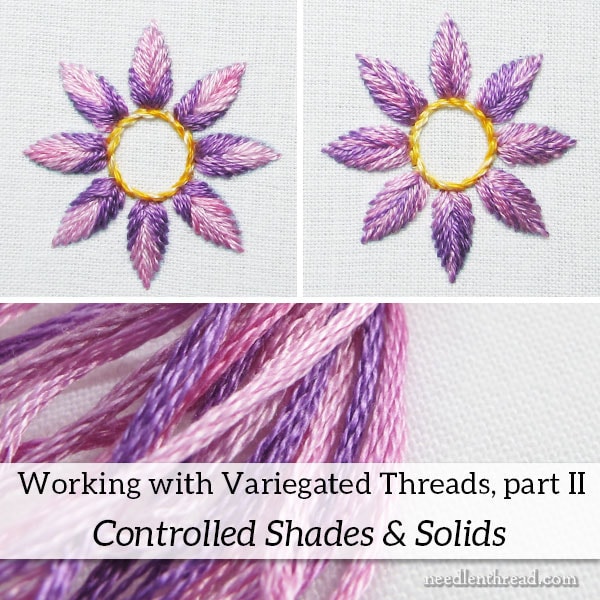
In the photo above, you can see the two flowers that will result from today’s efforts while working with variegated embroidery floss.
If you’re just joining in, please check out the first part of this series on how to use variegated threads in surface embroidery. There, you’ll find all the information on the supplies, threads, and stitches that I’m using in the samples.
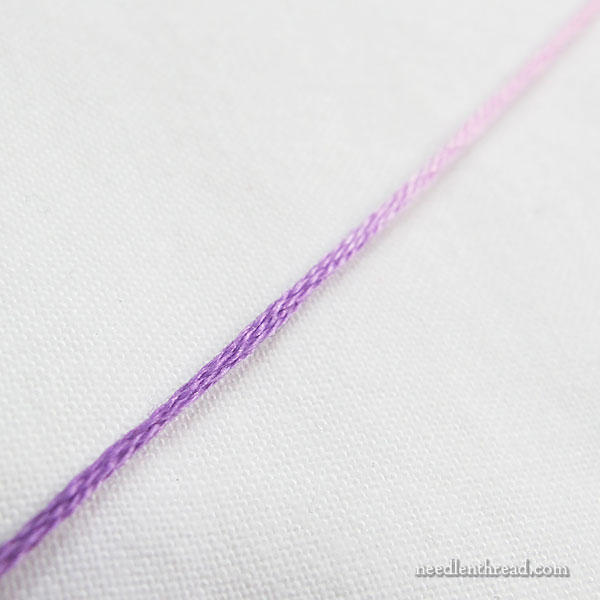
For the third sample, I’m going to embroider the same floral element using fishbone stitch in exactly the same way I stitched the two samples in Part I of this series.
The only difference in this sample is that I’m going to be mindful of how the colors unfold on each petal, controlling the shading by the way I cut the thread and thread my needle. I want this dark purple on the variegated thread to always (and only) fall at the base of each petal.
To achieve this, I have cut my thread a certain way, thread a certain end into the needle, and I might even have to end my threads in the middle of a petal and start a new thread, so that the purple will end up where I want it.
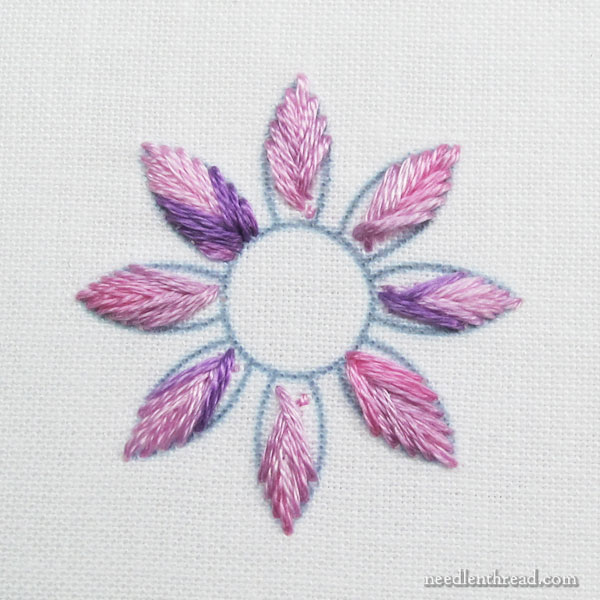
As it worked out, because the stretches of color are relatively long on DMC Variations for the size of the petals I was stitching, I had to embroider the petals part way down all the way around the flower, so that the lighter shades would always fall in the top two-thirds of each petal. If the darker purple began to develop, that was ok – but if not, I had to switch to the next petal to keep using the light shades on the upper petals.
To control the shade, I had to cut the threads so that one end had distinctly lighter shades on it, and the other, darker.
I had to make sure that, when I threaded the needle to start at the tip of a petal, I threaded it so that the darker shades were towards the needle and the lighter shades were towards the knot end of the thread. That way, the lighter shades ended up where I started the fishbone stitch (at the tip of the petal).

Then, I took the cut threads that had the purple at the knot end of the thread (as opposed to the needle end) and stitched the base of all the petals around the flower.
I could have trimmed the threads differently, to ensure that I had more of the transitional areas between the pink and purple showing up in the stitches. This is something you can gauge more carefully, depending on the look you want.
I was happy with the dark bases on these petals. I like the way the dark part of the petals seems to wrap around the light part. It’s nice to be able to achieve that look using the same skein of thread for the whole flower.
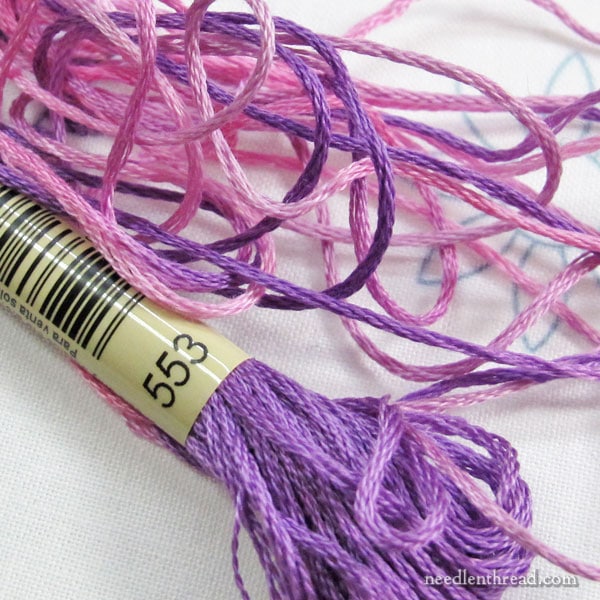
For the fourth sample demonstrating how to use variegated floss, I picked out a corresponding solid color of purple to stitch the sample.
With DMC Variations, you can actually color match the variegated colors in the thread with their line of solid embroidery floss. The printable PDF color chart linked to below can help you do that with many of the Variations colors, but it is missing their newer colors. I’ll update it when I can do the color matching! Here’s the partial chart for now, though:
DMC Variations & Corresponding Solids color chart
Without the chart, you can take the skein and color match it against solids that you might have in your stash. Or, if you have the DMC real thread color chart, you can use that to color match.
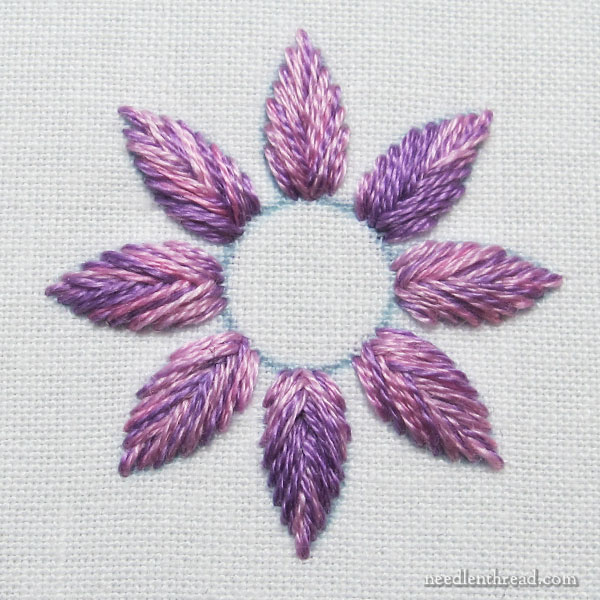
For this fourth sample, I used one strand of solid purple with two strands of variegated floss, one of which I reversed. So, the variegated floss strands are in opposite directions (which offsets their color sequences slightly), and there’s one consistent strand of purple running through every stitch.
This approach – which is a combination of sample 2 and a solid color – resulted in a nice, heathered effect, creating an overall purple impression with slight differences in depth of color and occasional flecks of lighter colors mixed in.
If you wanted to control the shading on this, you could combine the approach for sample 3 and sample 4. If you wanted it to look less heathered and a little more patchy, but with a consistent purple still running through it, you could combine the approach for sample 1 and sample 4.
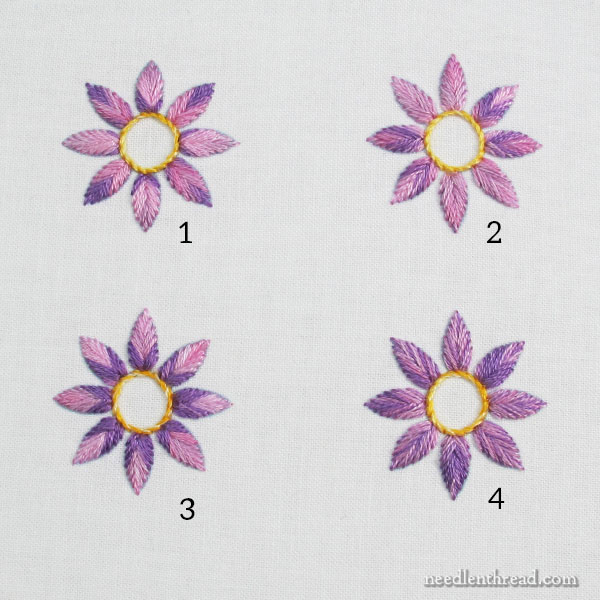
And here are the four samples together to give you an idea of how they differ.
To recap:
1 – Straight off the skein
2 – One strand of the three reversed
3 – Controlled color placement
4 – One strand of solid, two strands variegated arranged in opposite directions
I hope you enjoyed this series and that it gives you some ideas about how to play with variegated threads to achieve different results with your stitching!
If you have any questions, comments, or suggestions, feel free to join the conversation below.
In Other News…
For those who are stitching the tapestry smalls from A Thousand Flowers and who would like to add the deer featured in Monday’s article to your collection, the chart is now available in my shop.
Please read the description carefully – it is the chart only with no extra information. All the extra information, including stitching key, materials lists, and tips for stitching and finishing are found in the original e-book, A Thousand Flowers: Four Tapestry Smalls.
There are still a few more kits for A Thousand Flowers available, but they are diminishing pretty quickly! Grab yours today if you want one!